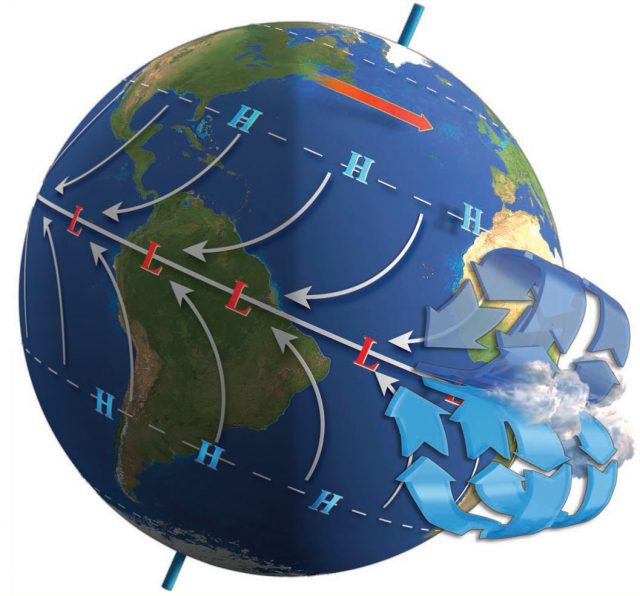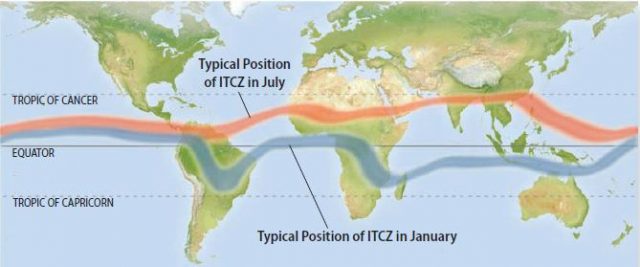How Does Air Circulate in the Tropics?
TROPICAL CIRCULATION is driven by the intense solar heating of land and seas near the equator. The heated air rises and spreads out from the equator, setting up huge, recirculating cells of flowing air. The rising air results in a belt of tropical low pressure, and where the air descends back toward the surface is a belt of subtropical high pressure. What determines where the rising and sinking occur, and how does the Coriolis effect influence this flow?
General Circulation in the Tropics
1. Examine the large figure below and note the main features. What do you observe, and can you explain most of these features using concepts you learned from previous parts of the chapter? Tropical areas are known for their lush vegetation, which in turn is due largely to relatively abundant and consistent insolation, warm temperatures, and abundant rainfall. After thinking about these aspects, read the rest of the text.

2. At the surface, winds generally converge on the equator from the north and south. The south-flowing winds in the Northern Hemisphere are apparently deflected to the right relative to their original path, blowing from the northeast. These winds are the northeast trade winds, so called because they guided sailing ships from the Old World (Europe and Africa) to the New World (the Americas).
3. In the Southern Hemisphere, winds blowing toward the equator are deflected to the left (west), resulting in winds blowing from the southeast, forming the southeast trade winds.
4. A belt of high pressure occurs near 30° N and 30° S, where air descends to the surface of the Earth. This air rose in the low pressure located near the equator, as a result of excess heating.

5. The rising and descending air, and the related high- and low-pressure areas, are linked together in a huge cell of convecting air — the Hadley cell. One Hadley cell occurs north of the equator and another just south of the equator.
6. Note that the Hadley cell extends to approximately 30° north and south of the equator, so it generally encompasses all the tropics and some distance beyond.
Formation of Hadley Cells
1. Insolation, on average, is most intense near the equator, in the tropics. The position of the overhead Sun migrates between the Tropic of Cancer and Tropic of Capricorn from season to season. The Sun-heated air rises from the tropics, forming a belt of low pressure at the surface. As the warm, moist air rises, the air cools somewhat, forming clouds; this accounts for the typical cloudiness and haziness of many tropical areas.

2. After rising, this air spreads out poleward as it approaches the upper boundary of the troposphere (the tropopause).
3. Once the upper-level flow reaches about 30° N and 30° S latitude, it sinks, both because it begins to cool aloft and due to forces arising from the Earth's rotation. This sinking air dynamically compresses itself and the surrounding air, producing the subtropical high-pressure systems.
4. Once near the surface, the air flows back toward the equator to replace the air that rose. The flow from the two hemispheres converges at the ITCZ.
Influence of the Coriolis Effect
5. As the air flows toward the equator in each hemisphere from the subtropical high to the ITCZ, the Coriolis effect pulls it to the right of its intended path (in the Northern Hemisphere) or left (in the Southern Hemisphere), as shown by the arrows on the left side of this diagram. The Coriolis effect is weak near the equator, however, so the deflection is only slight. The result is surface air flowing from northeast to southwest in the Northern-Hemisphere tropics (the northeast trade winds) and from southeast to northwest in the Southern-Hemisphere tropics (the southeast trade winds).

6. In the Northern Hemisphere, as the air flows poleward after rising at the ITCZ, the weak Coriolis effect also pulls the air slightly to the right of its intended path. The result is that some of the upperlevel air moves from southwest to northeast at the top of the Northern Hemisphere Hadley cell.
7. In the Southern Hemisphere, the Coriolis effect deflects the upper-level winds to the left of their intended path, causing a northwest-to-southeast low at the top of the Southern Hemisphere Hadley cell.
8. As the seasons progress, the set of Hadley cells and the ITCZ migrate — to the Northern Hemisphere in Northern-Hemisphere summer and to the Southern Hemisphere in Southern-Hemisphere summer. If the trade-wind flow crosses the equator, the Coriolis deflection begins to occur in the opposite direction, and the winds can reverse direction (not shown).
Seasonal Variations in the Position of the Intertropical Convergence Zone
9. As the overhead Sun shifts north and south within the tropics from season to season, the ITCZ shifts, too. In the northern summer, it shifts to the north. The typical June position of the ITCZ is the red line on the figure below, and the December position is the blue line.

10. The ITCZ generally extends poleward over large landmasses in the hemisphere that is experiencing summer. This larger shift over the land than over the oceans is because of the more intense heating of land surfaces.
11. Unlike the ITCZ, the subtropical high pressure doesn't exist in a continuous belt around the Earth. The ocean-covered surfaces support high pressure better than land surfaces because land heats up too much at these latitudes, especially in summer. The heated air over the land rises, counteracting the tendency for sinking air in the Hadley cell. So the subtropical high pressure tends to be more vigorous over the oceans.